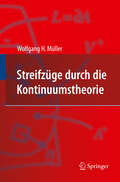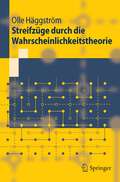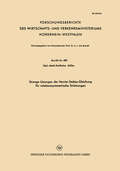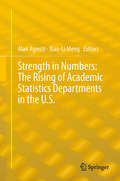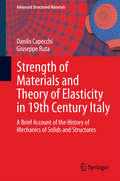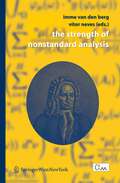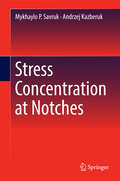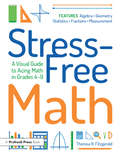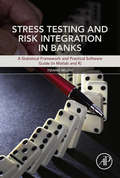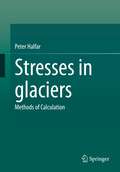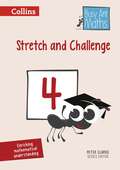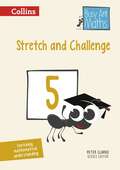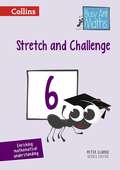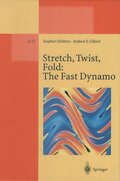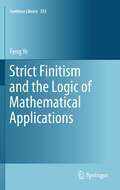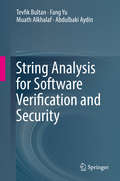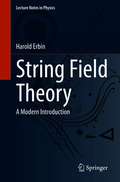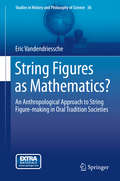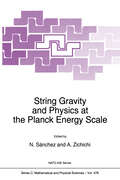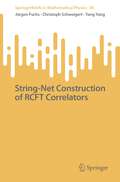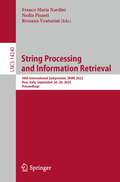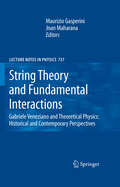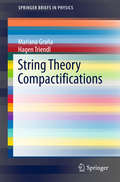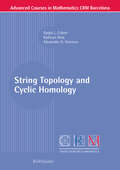- Table View
- List View
Streifzüge durch die Kontinuumstheorie
by Wolfgang H. MüllerDas Buch führt in die Bereiche der Kontinuumstheorie ein, die für Ingenieure relevant sind: die Deformation des elastischen und des plastifizierenden Festkörpers, die Strömung reibungsfreier und reibungsbehafteter Fluide sowie die Elektrodynamik. Der Autor baut die Theorie im Sinne der rationalen Mechanik auf, d. h., er erstellt ein Feldgleichungssystem und gibt – sozusagen nebenbei – eine Einführung in die Tensoranalysis. Dabei werden sowohl der Indexkalkül als auch die absolute Schreibweise verwendet und gegenübergestellt.
Streifzüge durch die Wahrscheinlichkeitstheorie (Springer-Lehrbuch)
by Olle HäggströmDies ist eine Einführung in die Wahrscheinlichkeitstheorie - der Mathematik des Zufalls. In einer mehr oder weniger losen Folge von Kapiteln werden veschiedene Themen angesprochen: Ein Teil behandelt klassische Begriffe, wie Irrfahrten oder die Gesetze der großen Zahlen, während andere Kapitel zeigen, wie die Mathematik in aktuelle Forschungen, z.B. die der Evolutionsbiologie, eingreift. Anschaulich wird der Zusammenhang zur Spieltheorie erläutert. Der Text widmet sich ausführlich einigen der am meisten diskutierten Paradoxa der Wahrscheinlichkeitstheorie, deren Betrachtung zu lehrreichen Einsichten führt. Einen wichtigen Raum nimmt auch die Perkolation und ihre Anwendungen ein, so wird zum Beispiel das so genannte "kleine Welt"-Phänomen mathematisch untersucht. Das Buch ist in erster Linie als Zusatzlektüre für Vorlesungen zur Stochastik und mathematischen Statistik im Grundstudium an Universität und Hochschule gedacht. Darüber hinaus gibt es Anregungen für Gymnasiallehrer und ihre Schüler. Häggströms Buch leistet für die Wahrscheinlichkeitstheorie das, was Jänichs für die Topologie tut.
Strenge Lösungen der Navier-Stokes-Gleichung für rotationssymmetrische Strömungen (Forschungsberichte des Wirtschafts- und Verkehrsministeriums Nordrhein-Westfalen #489)
by Karlheinz MüllerStrength in Numbers: The Rising of Academic Statistics Departments in the U. S.
by Alan Agresti and Xiao-Li MengStatistical science as organized in formal academic departments is relatively new. With a few exceptions, most Statistics and Biostatistics departments have been created within the past 60 years. This book consists of a set of memoirs, one for each department in the U.S. created by the mid-1960s. The memoirs describe key aspects of the department’s history -- its founding, its growth, key people in its development, success stories (such as major research accomplishments) and the occasional failure story, PhD graduates who have had a significant impact, its impact on statistical education, and a summary of where the department stands today and its vision for the future. Read here all about how departments such as at Berkeley, Chicago, Harvard, and Stanford started and how they got to where they are today. The book should also be of interests to scholars in the field of disciplinary history.
Strength of Materials and Theory of Elasticity in 19th Century Italy: A Brief Account of the History of Mechanics of Solids and Structures (Advanced Structured Materials #52)
by Danilo Capecchi Giuseppe RutaThis book examines the theoretical foundations underpinning the field of strength of materials/theory of elasticity, beginning from the origins of the modern theory of elasticity. While the focus is on the advances made within Italy during the nineteenth century, these achievements are framed within the overall European context. The vital contributions of Italian mathematicians, mathematical physicists and engineers in respect of the theory of elasticity, continuum mechanics, structural mechanics, the principle of least work and graphical methods in engineering are carefully explained and discussed. The book represents a work of historical research that primarily comprises original contributions and summaries of work published in journals. It is directed at those graduates in engineering, but also in architecture, who wish to achieve a more global and critical view of the discipline and will also be invaluable for all scholars of the history of mechanics.
The Strength of Nonstandard Analysis
by Imme Van Den Berg Vitor NevesThis book reflects the progress made in the forty years since the appearance of Abraham Robinson’s revolutionary book Nonstandard Analysis in the foundations of mathematics and logic, number theory, statistics and probability, in ordinary, partial and stochastic differential equations and in education. The contributions are clear and essentially self-contained.
Stress Concentration at Notches
by Mykhaylo P. Savruk Andrzej KazberukThis book compiles solutions of linear theory of elasticity problems for isotropic and anisotropic bodies with sharp and rounded notches. It contains an overview of established and recent achievements, and presents the authors’ original solutions in the field considered with extensive discussion. The volume demonstrates through numerous, useful examples the effectiveness of singular integral equations for obtaining exact solutions of boundary problems of the theory of elasticity for bodies with cracks and notches. Incorporating analytical and numerical solutions of the problems of stress concentrations in solid bodies with crack-like defects, this volume is ideal for scientists and PhD students dealing with the problems of theory of elasticity and fracture mechanics.
Stress-Free Math: A Visual Guide to Acing Math in Grades 4-9
by Theresa R. FitzgeraldEquipped with the #1 guide to help kids (and their parents) with math homework, students will be able to quickly find the definitions and illustrated examples that will enable them to solve many of the math challenges they face. Covering everything from "addend" to "zero," Stress-Free Math:Is perfect for both kids and their parents looking for help with math homework and the tools to ace the class!Gives students in grades 4-9 more than 400 definitions, full-color illustrations, and examples.Covers subjects like measurement, algebra, geometry, fractions and decimals, statistics and probability, and problem solving.Helps students solve math problems with confidence.Is a fully updated reimagining of the best-selling Math Dictionary for Kids.This well-organized and easy-to-follow quick reference guide includes illustrated, concise explanations of the most common terms used in general math classes. Packed with strategies to help students get better grades and master math concepts without any headaches, this math study guide also discusses how students can use manipulatives and basic math tools to improve their understanding and includes handy measurement conversion tables, guides to geometric shapes, and more. Each concept covered has a concise definition and an example or illustration.Grades 4-9
Stress-Free Math: A Visual Guide to Acing Math in Grades 4-9
by Theresa R. FitzgeraldEquipped with the #1 guide to help kids (and their parents) with math homework, students will be able to quickly find the definitions and illustrated examples that will enable them to solve many of the math challenges they face. Covering everything from "addend" to "zero," Stress-Free Math:Is perfect for both kids and their parents looking for help with math homework and the tools to ace the class!Gives students in grades 4-9 more than 400 definitions, full-color illustrations, and examples.Covers subjects like measurement, algebra, geometry, fractions and decimals, statistics and probability, and problem solving.Helps students solve math problems with confidence.Is a fully updated reimagining of the best-selling Math Dictionary for Kids.This well-organized and easy-to-follow quick reference guide includes illustrated, concise explanations of the most common terms used in general math classes. Packed with strategies to help students get better grades and master math concepts without any headaches, this math study guide also discusses how students can use manipulatives and basic math tools to improve their understanding and includes handy measurement conversion tables, guides to geometric shapes, and more. Each concept covered has a concise definition and an example or illustration.Grades 4-9
Stress Testing and Risk Integration in Banks: A Statistical Framework and Practical Software Guide (in Matlab and R)
by Tiziano BelliniStress Testing and Risk Integration in Banks provides a comprehensive view of the risk management activity by means of the stress testing process. An introduction to multivariate time series modeling paves the way to scenario analysis in order to assess a bank resilience against adverse macroeconomic conditions. Assets and liabilities are jointly studied to highlight the key issues that a risk manager needs to face. A multi-national bank prototype is used all over the book for diving into market, credit, and operational stress testing. Interest rate, liquidity and other major risks are also studied together with the former to outline how to implement a fully integrated risk management toolkit. Examples, business cases, and exercises worked in Matlab and R facilitate readers to develop their own models and methodologies.Provides a rigorous statistical framework for modeling stress test in line with U.S. Federal Reserve FRB CCAR (Comprehensive Capital Analysis Review), U.K. PRA (Prudential Regulatory Authority), EBA (European Baning Authorithy) and comply with Basel Accord requirementsFollows an integrated bottom-up approach central in the most advanced risk modelling practiceProvides numerous sample codes in Matlab and R
Stresses in glaciers: Methods of Calculation
by Peter HalfarIn this book, for the first time, a hitherto unknown general solution of the reliably known stress conditions is presented. This general solution forms a reliable and new starting point to get further in stress calculations than before. In this way, approximately realistic solutions can be found despite a recurring problem: the information deficits that are unavoidable due to the difficulty of exploring glaciers. This issue is demonstrated by the example of stagnating glaciers. For horizontally isotropic homogeneous tabular iceberg models, even mathematically exact unambiguous solutions of all relevant conditions are presented. All calculations use only elementary arithmetic operations, differentiations and integrations. The mathematical fundamentals are presented in detail and explained in many application examples. The integral operators specific to calculations of stresses facilitate the mathematical considerations. The stand-alone text allows the reader to understand what is involved even without considering the formulas. The author Peter Halfar is a theoretical physicist. He also developed a model of the movement of large ice caps (1983), which is still in use today.
Stretch And Challenge 4 (Busy Ant Maths) (PDF)
by Peter ClarkeChallenge and stretch Year 4 pupils with this resource designed to broaden and deepen children's mathematical understanding. This book supports the classroom teacher in delivering structured guidance and support for gifted children who are exceeding age-related expectations in mathematics. contains 36 photocopiable newspaper-style issues packed with investigations, problem-solving activities and maths challenges specific teacher guidance (and answers) in the accompanying teachers notes for all 36 issues all content is within the years programme of study evaluate children's learning and identify the next steps for progression with detailed assessment guidance encourage children to apply their mathematical knowledge and skills across the curriculum with cross-curricular activities
Stretch And Challenge 5: (PDF) (Busy Ant Maths Series)
by Peter ClarkeChallenge and stretch Year 5 pupils with this resource designed to broaden and deepen children’s mathematical understanding. This book supports the classroom teacher in delivering structured guidance and support for gifted children who are exceeding age-related expectations in mathematics. contains 36 photocopiable newspaper-style issues packed with investigations, problem-solving activities and maths challenges specific teacher guidance (and answers) in the accompanying teachers notes for all 36 issues all content is within the years programme of study evaluate children’s learning and identify the next steps for progression with detailed assessment guidance encourage children to apply their mathematical knowledge and skills across the curriculum with cross-curricular activities
Stretch and Challenge 6 (Busy Ant Maths Ser.)
by Peter ClarkeChallenge and stretch Year 6 pupils with this resource designed to broaden and deepen children’s mathematical understanding. This book supports the classroom teacher in delivering structured guidance and support for gifted children who are exceeding age-related expectations in mathematics.
Stretch, Twist, Fold: The Fast Dynamo (Lecture Notes in Physics Monographs #37)
by Stephen Childress Andrew D. GilbertThe study of the magnetic fields of the Earth and Sun, as well as those of other planets, stars, and galaxies, has a long history and a rich and varied literature, including in recent years a number of review articles and books dedicated to the dynamo theories of these fields. Against this background of work, some explanation of the scope and purpose of the present monograph, and of the presentation and organization of the material, is therefore needed. Dynamo theory offers an explanation of natural magnetism as a phenomenon of magnetohydrodynamics (MHD), the dynamics governing the evolution and interaction of motions of an electrically conducting fluid and electromagnetic fields. A natural starting point for a dynamo theory assumes the fluid motion to be a given vector field, without regard for the origin of the forces which drive it. The resulting kinematic dynamo theory is, in the non-relativistic case, a linear advection-diffusion problem for the magnetic field. This kinematic theory, while far simpler than its magnetohydrodynamic counterpart, remains a formidable analytical problem since the interesting solutions lack the easiest symmetries. Much ofthe research has focused on the simplest acceptable flows and especially on cases where the smoothing effect of diffusion can be exploited. A close analog is the advection and diffusion of a scalar field by laminar flows, the diffusion being measured by an appropriate Peclet number. This work has succeeded in establishing dynamo action as an attractive candidate for astrophysical magnetism.
Strict Finitism and the Logic of Mathematical Applications (Synthese Library #355)
by Feng YeThis book intends to show that radical naturalism (or physicalism), nominalism and strict finitism account for the applications of classical mathematics in current scientific theories. The applied mathematical theories developed in the book include the basics of calculus, metric space theory, complex analysis, Lebesgue integration, Hilbert spaces, and semi-Riemann geometry (sufficient for the applications in classical quantum mechanics and general relativity). The fact that so much applied mathematics can be developed within such a weak, strictly finitistic system, is surprising in itself. It also shows that the applications of those classical theories to the finite physical world can be translated into the applications of strict finitism, which demonstrates the applicability of those classical theories without assuming the literal truth of those theories or the reality of infinity.Both professional researchers and students of philosophy of mathematics will benefit greatly from reading this book.
String Analysis for Software Verification and Security
by Tevfik Bultan Fang Yu Muath Alkhalaf Abdulbaki AydinThis book discusses automated string-analysis techniques, focusing particularly on automata-based static string analysis. It covers the following topics: automata-bases string analysis, computing pre and post-conditions of basic string operations using automata, symbolic representation of automata, forward and backward string analysis using symbolic automata representation, constraint-based string analysis, string constraint solvers, relational string analysis, vulnerability detection using string analysis, string abstractions, differential string analysis, and automated sanitization synthesis using string analysis. String manipulation is a crucial part of modern software systems; for example, it is used extensively in input validation and sanitization and in dynamic code and query generation. The goal of string-analysis techniques and this book is to determine the set of values that string expressions can take during program execution. String analysis can be used to solve many problems in modern software systems that relate to string manipulation, such as: (1) Identifying security vulnerabilities by checking if a security sensitive function can receive an input string that contains an exploit; (2) Identifying possible behaviors of a program by identifying possible values for dynamically generated code; (3) Identifying html generation errors by computing the html code generated by web applications; (4) Identifying the set of queries that are sent to back-end database by analyzing the code that generates the SQL queries; (5) Patching input validation and sanitization functions by automatically synthesizing repairs illustrated in this book. Like many other program-analysis problems, it is not possible to solve the string analysis problem precisely (i.e., it is not possible to precisely determine the set of string values that can reach a program point). However, one can compute over- or under-approximations of possible string values. If the approximations are precise enough, they can enable developers to demonstrate existence or absence of bugs in string manipulating code. String analysis has been an active research area in the last decade, resulting in a wide variety of string-analysis techniques. This book will primarily target researchers and professionals working in computer security, software verification, formal methods, software engineering and program analysis. Advanced level students or instructors teaching or studying courses in computer security, software verification or program analysis will find this book useful as a secondary text.
String Field Theory: A Modern Introduction (Lecture Notes in Physics #980)
by Harold ErbinThis textbook provides an introduction to string field theory (SFT). String theory is usually formulated in the worldsheet formalism, which describes a single string (first-quantization). While this approach is intuitive and could be pushed far due to the exceptional properties of two-dimensional theories, it becomes cumbersome for some questions or even fails at a more fundamental level. These motivations have led to the development of SFT, a description of string theory using the field theory formalism (second-quantization). As a field theory, SFT provides a rigorous and constructive formulation of string theory. The main focus of the book is the construction of the closed bosonic SFT. The accent is put on providing the reader with the foundations, conceptual understanding and intuition of what SFT is. After reading this book, the reader is able to study the applications from the literature. The book is organized in two parts. The first part reviews the notions of the worldsheet theory that are necessary to build SFT (worldsheet path integral, CFT and BRST quantization). The second part starts by introducing general concepts of SFT from the BRST quantization. Then, it introduces off-shell string amplitudes before providing a Feynman diagrams interpretation from which the building blocks of SFT are extracted. After constructing the closed SFT, the author outlines the proofs of several important properties such as background independence, unitarity and crossing symmetry. Finally, the generalization to the superstring is also discussed.
String Figures as Mathematics?: An Anthropological Approach to String Figure-making in Oral Tradition Societies (Studies in History and Philosophy of Science #36)
by Eric VandendriesscheThis book addresses the mathematical rationality contained in the making of string figures. It does so by using interdisciplinary methods borrowed from anthropology, mathematics, history and philosophy of mathematics. The practice of string figure-making has long been carried out in many societies, and particularly in those of oral tradition. It consists in applying a succession of operations to a string (knotted into a loop), mostly using the fingers and sometimes the feet, the wrists or the mouth. This succession of operations is intended to generate a final figure. The book explores different modes of conceptualization of the practice of string figure-making and analyses various source material through these conceptual tools: it looks at research by mathematicians, as well as ethnographical publications, and personal fieldwork findings in the Chaco, Paraguay, and in the Trobriand Islands, Papua New Guinea, which all give evidence of the rationality that underlies this activity. It concludes that the creation of string figures may be seen as the result of intellectual processes, involving the elaboration of algorithms, and concepts such as operation, sub-procedure, iteration, and transformation.
String Gravity and Physics at the Planck Energy Scale (Nato Science Series C: #476)
by Norma G. Sànchez Antonino ZichichiThe contemporary trends in the quantum unification of all interactions including gravity motivate this Course. The main goal and impact of modern string theory is to provide a consistent quantum theory of gravity. This, Course is intended to provide an updated understanding of the last developments and current problems of string theory in connection with gravity and the physics at the Planck energy scale. It is also the aim of this Course to discuss fundamental problems of quantum gravity in the present-day context irrespective of strings or any other models. Emphasis is given to the mutual impact of string theory, gravity and cosmology, within a deep a well defined programme, which provides, in addition, a careful interdisciplinarity. Since the most relevant new physics provided by strings concerns the quantization of gravity, we must, at least, understand string quantization in curved space-times to start. Curved space-times, besides their evident relevance m classical gravitation, are also important at energies of the order of the Planck scale. At the Planck energy, gravitational interactions are at least as important as the rest and can not be neglected anymore. Special care is taken here to provide the grounds of the different lines of research in competition (not just only one approach); this provides an excellent opportunity to learn about the real state of the discipline, and to learn it in a critical way.
String-Net Construction of RCFT Correlators (SpringerBriefs in Mathematical Physics #45)
by Jürgen Fuchs Christoph Schweigert Yang YangThis book studies using string-net models to accomplish a direct, purely two-dimensional, approach to correlators of two-dimensional rational conformal field theories. The authors obtain concise geometric expressions for the objects describing bulk and boundary fields in terms of idempotents in the cylinder category of the underlying modular fusion category, comprising more general classes of fields than is standard in the literature. Combining these idempotents with Frobenius graphs on the world sheet yields string nets that form a consistent system of correlators, i.e. a system of invariants under appropriate mapping class groups that are compatible with factorization. The authors extract operator products of field objects from specific correlators; the resulting operator products are natural algebraic expressions that make sense beyond semisimplicity. They also derive an Eckmann-Hilton relation internal to a braided category, thereby demonstrating the utility of string nets for understanding algebra in braided tensor categories. Finally, they introduce the notion of a universal correlator. This systematizes the treatment of situations in which different world sheets have the same correlator and allows for the definition of a more comprehensive mapping class group.
String Processing and Information Retrieval: 30th International Symposium, SPIRE 2023, Pisa, Italy, September 26–28, 2023, Proceedings (Lecture Notes in Computer Science #14240)
by Franco Maria Nardini Nadia Pisanti Rossano VenturiniThis volume LNCS 14240 constitutes the refereed proceedings of the 30th International Symposium on String Processing and Information Retrieval, SPIRE 2023, held in Pisa, Italy, during September 26–28, 2023. The 31 full papers presented were carefully reviewed and selected from 47 submissions. They cover topics such as: data structures; algorithms; constrained Substring complexity; data compression codes; succinct k-spectra; and LCP array of wheeler DFAs.
String Theory and Fundamental Interactions: Gabriele Veneziano and Theoretical Physics: Historical and Contemporary Perspectives (Lecture Notes in Physics #737)
by Maurizio Gasperini Jnan MaharanaThis book has been prepared to celebrate the 65th birthday of Gabriele Veneziano and his retirement from CERN in September 2007. This reti- ment certainly will not mark the end of his extraordinary scienti?c career (in particular, he will remain on the permanent sta? of the Coll` ege de France in Paris), but we believe that this important step deserves a special celebration, and an appropriate recognition of his monumental contribution to physics. Our initial idea of preparing a volume of Selected papers of Professor Gabriele Veneziano, possibly with some added commentary, was dismissed when we realized that this format of book, very popular in former times, has become redundant today because of the full “digitalization” of all important physical journals, and their availability online in the electronic archives. We have thus preferred an alternative (and unconventional, but probably more e?ective) form of celebrating Gabriele’s birthday: a collection of new papers written by his main collaborators and friends on the various aspects of th- retical physics that have been the object of his research work, during his long and fruitful career.
String Theory Compactifications (SpringerBriefs in Physics)
by Mariana Graña Hagen TriendlThe lectures in this book provide graduate students and non-specialist researchers with a concise introduction to the concepts and formalism required to reduce the ten-dimensional string theories to the observable four-dimensional space-time - a procedure called string compactification. The text starts with a very brief introduction to string theory, first working out its massless spectrum and showing how the condition on the number of dimensions arises. It then dwells on the different possible internal manifolds, from the simplest to the most relevant phenomenologically, thereby showing that the most elegant description is through an extension of ordinary Riemannian geometry termed generalized geometry, which was first introduced by Hitchin. Last but not least, the authors review open problems in string phenomenology, such as the embedding of the Standard Model and obtaining de Sitter solutions.
String Topology and Cyclic Homology (Advanced Courses in Mathematics - CRM Barcelona)
by Ralph L. Cohen Kathryn Hess Alexander A. VoronovThis book explores string topology, Hochschild and cyclic homology, assembling material from a wide scattering of scholarly sources in a single practical volume. The first part offers a thorough and elegant exposition of various approaches to string topology and the Chas-Sullivan loop product. The second gives a complete and clear construction of an algebraic model for computing topological cyclic homology.
